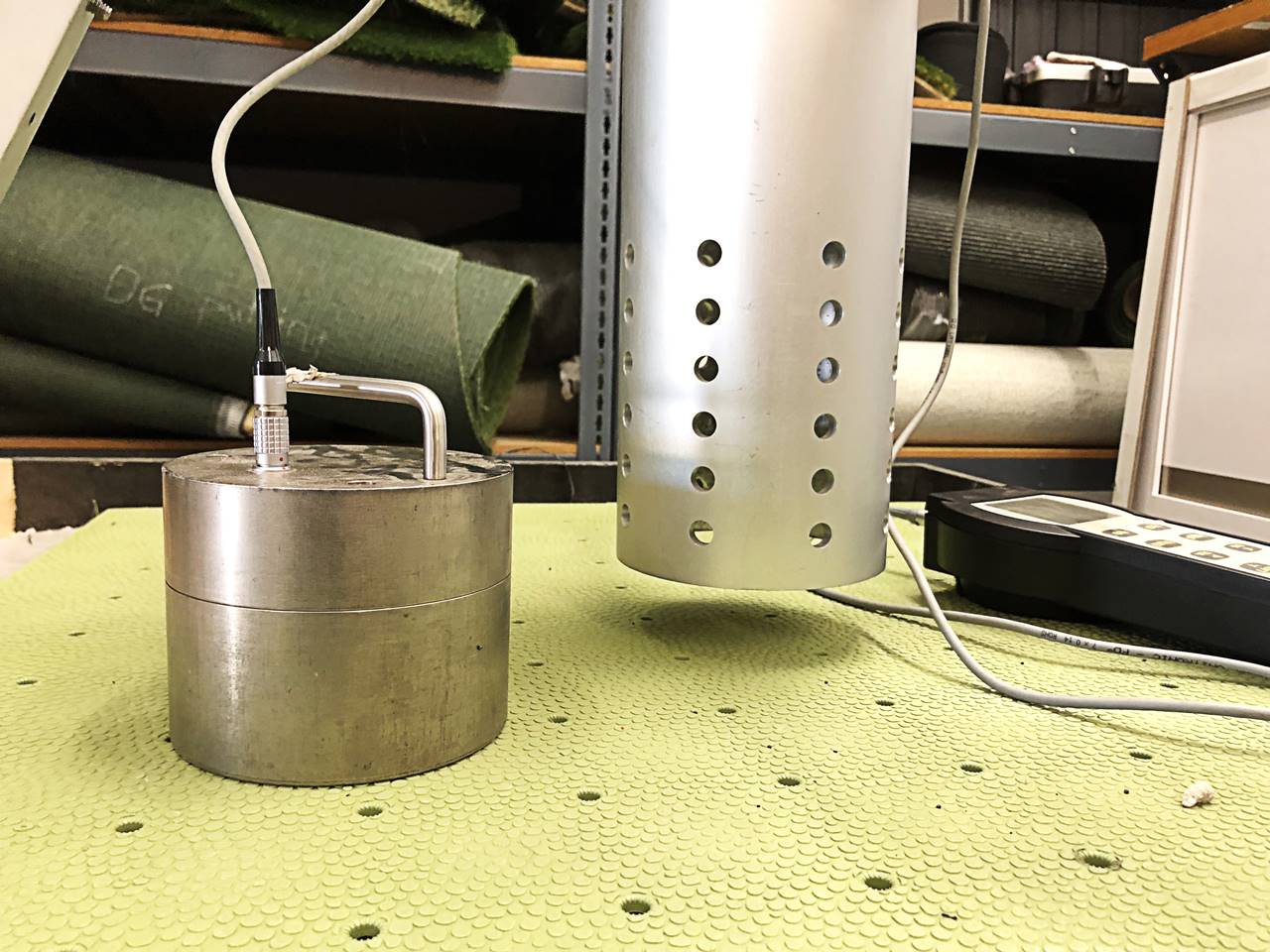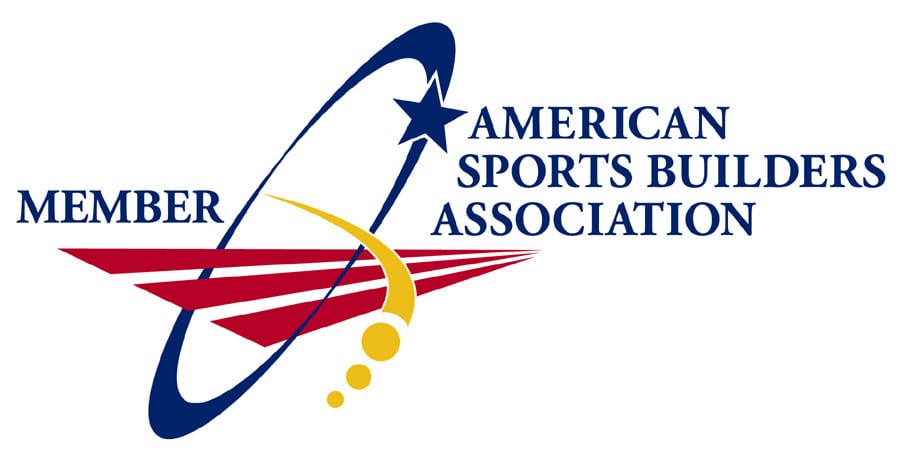
What is GMAX and HIC - Why it Matters for Fields and Playgrounds
Read Video Transcript and Main Points Addressed Below
Okay, as you guys all know there are a lot of terms out there that have to do with, synthetic turf, playgrounds, and fields performance. You’ve got FIFA that has an entire standard of the way a FIFA one star or two star field needs to perform. There’s the ASTM numbers for GMAX and HIC.

So What Is GMAX and HIC?
You know when I first started this thing it was like what in the heck is everybody talking about? You know, what are all these tests what do they all mean? So I wanted to kind of give you a brief breakdown, of what, you know in simple terms what all these terms mean. And what we’re going to do after, were going to take you in the back of the inner sanctum and kind of show you some of the testing equipment, that we’ve got there, that is pretty much standard that’s used across the industry to determine the performance and the safety of different tests.
Understanding The Components of GMAX
Our different products ranging from the fields to the playgrounds. So let’s start with the first one, GMAX. Essentially GMAX is a measurement of the impact if you will, and I’ll break this down in real simple terms. Of the impact on a surface, and this is done with a twenty pound flat missile. It looks like the cylinder has been cut off from the bottom, you will see it when we go back there. And it’s dropped from two feet and ASTM says that GMAX number needs to be under 200 and that’s what they consider to be the top level of what can be safe to prevent concussion. Above that it’s going to be a concussion factor.
And a lot of what we are talking about here is what we are seeing in the automobile industry, we’ve all seen the commercial with the dummies flying forward, well they are all being tested with the accelerometers and determining what is that force, what is that GMAX. You know what is that going to do to your brain? So the GMAX, is the test that is done probably on every field out there, before playing. Especially with college fields and sports fields. There’s a couple of devices there’s the Clegg, that is used by some and there’s also now where we have the Triax machine that determines GMAX. So think about GMAX being that number that tells you for concussion and head injury.
That same Triax machine but in a much larger version, is a device that’s used to gain what’s called HIC. H-I-C. And HIC is a playground number primarily here in the states, other places in the world, that’s used for, determining impact.
Getting The Components of HIC
But HIC is a different missile, almost the shape of a small child’s head and it’s spherical on the bottom, and its dropped, it weighs ten pounds. Where the GMAX missile weighed twenty, this weighs ten and its dropped from a variety of heights. So if I want a three foot playground fall, for little kids, I’ve got to have a number that comes in under 1000 HIC. Now there are some talk about that number coming to 700 though ASTM, right now its still 1000. So every time you go up in height, you got to make sure that the HIC number is below a thousand.
So, in our case with some of our panels like MAX panel we can get it 3 or 4 feet, you know 3 or 4 hundred HIC. That’s awesome, well go higher it may go to six or seven, and at some point it’s going to peak and go over a thousand. When it’s over a thousand it fails it won’t pass, that gets up there probably closer to the 8,9,10,11 foot heights. So HIC is a number that is used across the country to determine your playgrounds. You’ll see guys go out there and take a rig and they will bring that to a playground and they will test for example where kids come off of swings or under monkey bars, there really for fall zones. And so that is the number that’s used for that testing.
How Energy Restitution Comes Into Play
One of my favorite things to think about and talk about is energy restitution. And what does that mean? Well, energy restitution is the amount of energy if you will that comes back to the athlete. And again I’m breaking this down I’m not a scientist I’m an art major. But I’m breaking this down to simple terms it really determines the energy that goes back to the athlete and I’ll describe it this way. If you are running on the beach and your running on the waters edge, you are running on a very, very hard surface. If you fall on that surface it’s going to hurt, because it’s hard, so the GMAX would be high. But the energy restitution number is going to be very, very good because the ground is firm and you are coming off of it and your foot is planting and driving the energy back to the athlete and that’s performance.
If I’m up on the Sand dunes I can run you know fall down, it’s not going to hurt, I’m not going to get a concussion but I’m going to be exhausted, because the sand is soft. It’s going to give me low energy restitution. Somewhere between the waters edge and the sand is the promised land. And we believe that’s what we’ve accomplished especially with our Ultra Base MAX, and we’ll be talking a lot more about that in the upcoming month or so, when we actually begin to launch that product. We are doing a lot of testing right now in labs all over the world to show that we are what we think is the final solution for the best field safety and performance out there.
Other tests your looking at, are foot rotation. And what does that mean? Well when we tested the other device, that basically has cleats of a football shoe or soccer shoe, and they push it down and they load it and it spins, and the determining the amount of grab. Remember you want your foot to be able to move through the turf and not grab your ankle and cause a ankle break or a low extremity injury, knee blow out.
Remember, if you think about this, everybody is trying to replicate natural grass, that’s what the goal of synthetic grass, the advantage of synthetic grass is that you play on it 24/7. Compared to a natural grass field. But everybody’s trying for natural grass numbers. So when you look at things like GMAX or HIC or foot rotation or ball bounce, how high the ball comes off the surface, ball roll, how well does the ball roll across the surface and the turf. These are all test along with critical fall height, which is more of a number that’s used a lot in Europe, especially in the world of rugby. Trying to determine the fall height values where it’s safe to fall from. All these things are tests that are done through testing organizations in the United States, New York, to try to create the best and the safest fields possible.
So, we just kind of wanted to give you a little heads up, on our website we kind of describe it again some of these numbers and we show these terms rather, what they mean and show how our numbers relate. But I just want to kind of give you a brief understanding of what these things are and we will take you in the back and were going to actually show you some of these tests happening so you can get a better, clear idea of when someone throws a number out, we want a GMAX you get a spec from an architect saying hey we want a GMAX to not to exceed 120. Well what the heck does that mean? So were going to explain a lot of that to you. So many of these numbers are affected by the type of turf, the amount of infill, the type of infill, the ground preparation. So it’s really a moving target, But were going to give you an understanding of what they mean in general terms.
How the Machine and Tests Work
We touched on GMAX and HIC and all the different things that it does for us as designers in sports fields. Want to show you exactly what this machine looks like and really, how it works before I bought one of these Triax machines I had never really seen it work and understand all the idiosyncrasy’s of it. So essentially this is the machine that’s used to test GMAX for sports field and this one is made by tri ax. And this will allow us – it has an accelerometer, in the very top of it, which is basically what’s going to determine the impact on to our surface. Now this little device, this missile if you will, is a twenty pound missile that drops from two feet and as it comes down onto the turf or panel, it’s going to register a number. Now ASPN says in this case for GMAX the number has to be below 200. That’s the number they determine to be critical for a head concussion. So you want that number to be below 200.
Finding the Sweet Spot for ASTM
Its changed a lot over the years as far as what guys are striving for but again the number ASTM has to be below 200. I want to kind of show you some of the things that you do when your setting this thing up. Um first thing is that in this case we have this on concrete, um, Scott Ford over here, and Scott really knows a lot about the whole FIFA testing. When FIFA tests they always want the protocol to be on concrete. Behind us, we have a rock box and we will show you this in a little bit and that’s just basically a box that we created that looks like compacted earth. But, FIFA wants you to test on concrete, you know that is a constant, well how hard is the rock, how much is it compacted? Concretes concrete for the most part. So we like to test on concrete and it also gives you your worst scenario. If you don’t test well on concrete, then you won’t test well anywhere. So what we’ve done is we’ve got the concrete, we have the new Ultra Base MAX panel and this is the panel we developed that is our tried and true rigid Ultra Base panel that’s coupled with a huge piece of shock absorption foam.
Process We Use When Testing
So, when your setting this thing up the first thing you have to make sure of is, that from the center of the knob to the turf it has to be 24 inches. Make sure you have a twenty four inch drop. And you’ve also got to make sure that your tube is level in all directions. So we always do that to make sure everything is level. Now this device is all registered on to a hand held computer. This is going to tell us our GMAX number.
So um Scott got this all set up and this missiles going to plunge down, hit the ground and going to register a GMAX number so let’s just see what we get here. So remember this is our Ultra Base panel on concrete and this is an inch and a half turf, no infill, just down and dirty. So let’s see what we get here.
I’m going to kind of hold this steady so it doesn’t bounce, cause it comes down with a force you know, you don’t want your toe under it. Alright so this shows a GMAX of 90. Now that is a ridiculously good number. I really didn’t want this to be an advertisement but, this panel is amazing. I mean the GMAX numbers are just insanely low. But the energy restitution number which is another series of tests which is energy back to the athlete is phenomenally good. So, this is kind of why we really think this is the one that cracks the code here. This is amazing panel what we would do here typically, we take 3 measurements and average them out. Then that tells you what your number is. So um this is all these guys are doing.
Now when doing GMAX on a field, your testing multiple locations around the field. They are doing center, goal line, different places and then determine how the field is, when you’ve got somebody coming to test the fields, there going to grab all these different locations do three drops in each and then there going to tell you where your field is hard or soft and typically the problem with some fields is that, like especially compacted stone fields the very center of the field especially in football, is very, very hard, because there is so much play there and so much pounding. Um but this is pretty much you know how the industry does it.
There’s also a play machine that tests a little bit different but still going off numbers dealing with head concussion. But this is what we’ve got and one that really allows the sports lab around the country use. Okay, another way to test is on compacted sub grade and in our shop here we have mounted to our floor, a box that’s with compacted stone and basically about four to four and a half inch stone. And this allows us to see what a test may be in an actual stone based construction, rather than on concrete.
So what we do here is I’m going to do a different panel, um we always start with our synthetic stabilization fabric, and you guys hear me preach this all the time, this is not a weed cloth this is meant as a stabilizer. I call it snow shoes for our panels, it really means that two main properties, well three main properties have to drain or not drain, has to have high tensile strength and low elongation. And what we mean by that, again, is we want the panel to rest on this and not embedded in.
So this case we are bringing in the champion panel, this is our champion panel and we are going to lay this guy right on top of this panel, and this is really what you would see on many fields. We did probably a dozen fields this year, in this situation right here. So were going to get set up and we will show you a couple of GMAX drops on a system like this. So you’ve got what represents an earth or stone based, and of course we already showed you what we do on concrete, asphalt in those scenarios.
Okay, so we are set up again for another GMAX test. We’ve gone 24 inches from the center of the knob to the turf, same exact turf as before. The difference is this is a Champion panel on fabric on rock. Now I’m going to expect to see a different um GMAX than the MAX panel because the max panel has all that shock absorption foam that’s coupled into it. But this product still, Champion produces amazing thing, we don’t absorb energy, we dissipate energy. And what I mean by that, is that when the missile comes down the energy radiates out. And I’ll tell a real quick story, when we did our first sports field in a very large testing lab come down and they actually thought that their machinery was malfunctioning because it was GMAXing so well.
And after they re-calibrated it, they were standing 3 or 4 feet away, and they got the missile and one of the technicians said that he felt the vibration in his feet. And what – we knew that in this case because we knew that we weren’t just taking energy and absorbing it in the ground, we are taking and dissipating outwards like dropping a pebble into a pond, so that’s why we make great energy restitution, cause we are driving energy back up, so um let’s see what we have here and see if I’m right. 96 still, really good number. Remember, this turf has no infill in it. Its rock base so the rock base kind of moves a little. If this had been on the concrete it would have been a little higher maybe 130. Still a great number, remember 200 is failing, 130, 140, 150 are good numbers it’s just that the industry is kind of having a different thought process about low GMAX field. My problem with that is, until MAX I thought that these low GMAX fields are soft, like playing on a mattress. The MAX panel, I showed you earlier doesn’t do that, but this is typically how this is happening in a field.
Again we’ve done probably a dozen fields this year, typically they have been through couple thousand sand and rubber, three or four pounds of sand and rubber, but as you see, a number of 96, on a stone base, is a ridiculously good number. Then you get the added advantage from the panel, in this case, storage of water underneath and vertical and horizontal flow. So,Um, we just wanted to show you these two things of how GMAX works. Next were going to move over to HIC and will um set that up and show you how we test for playgrounds.
Okay, this is the next device. This is the Triax machine that is designed to test for playgrounds. Now a big difference between this is really the missile and the fact that the energy can go up almost 12 feet. The missile is a ten pound missile it’s semi spherical kind of like a child’s small head and that’s dropped onto the surface at a particular height, and that creates the HIC number. Now in this case we have it set at four feet, measure from the top of the turf to the bottom of the missile.
Now the HIC numbers for ASTM say it has to be under 1000. Now there is talk about this number going to 700. But right now it is still at a thousand. So that means if you test at a particular fall height, and you test under one thousand then you receive a pass. If this test and it comes in at 650, at 4 feet, and you can keep taking this drop up, until you get the point where you cross over a thousand and then of course at that point it’s a fail. So this unit now, is primarily used in the playground world. So um were going to, this is kind of a two man operation.
Scott’s going to drop and I’m going to catch it and he’s going to call out the number to me. So were at the, let’s talk about what we’ve got here? Rock base geo stabilization fabric, the new max panel, uhm the great thing about the max, is we see this often becoming a playground panel for us because the way we designed it, we can change the density of the foam, and the thickness of the foam and by changing like the softer foam and the thickness of the foam we can go off higher fall height. What I like about it, is we still have this hard surface. So that less likely for seams of turf, to want to break apart and pop apart, wheelchairs can go across it.
My thing is you are walking on a solid surface, it just happens to perform like a shock pad. So um, anyway let’s see what we have here. Okay so he said 580 HIC. So that is a very good drop, that’s a big pass. That means that this system with this piece of turf with no infill on the MAX panel on rock, is a pass, this can be put anywhere on a playground and this will pass. So we just kind of progressively go up further and further in heights, and like I said once you cross that number that your above a thousand, you fail. And then you can do things like changing the infill amount or the type of turf. So there’s all kinds of things you can do to manipulate that number to work for you, but this is down and dirty, um inch and a half turf, no fill on max panel and this is a pass.








